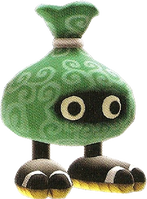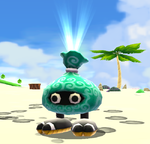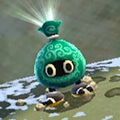Tracks (enemy)
| Tracks | |||
|---|---|---|---|
 Artwork from Super Mario Galaxy | |||
| First appearance | Super Mario Galaxy (2007) | ||
| Latest appearance | Super Mario Galaxy + Super Mario Galaxy 2 (2025) | ||
| |||
Tracks[1][2] are enemies that appear in Super Mario Galaxy and Super Mario Galaxy 2. They are turquoise sack-like creatures similar to Moneybags, with their pattern resembling a karakusa moyou (commonly associated with Japanese thief clothes). Each Tracks has legs ending in gray, geta sandal-clad feet; a pair of eyes resembling those of a Blooper; and a beam of light emanating from the bag's opening. Tracks commonly appear in beaches and other sandy or dirt-filled areas, and have the ability to become invisible.
History[edit]
Super Mario Galaxy[edit]
Tracks first appear as uncommon enemies in Super Mario Galaxy and its Nintendo Switch port. A Tracks is visible only when Mario (or Luigi) stands still, and it becomes invisible and starts running away from Mario if he moves. The only indication of the invisible Tracks' location is the footprints it leaves in the dirt as it flees (hence the name), as well as the slapping noise that comes from its steps. If Mario hits an invisible Tracks with a spin, it becomes visible and remains dizzy for a few seconds. Mario can defeat a Tracks by tossing a shell or a fireball at it, though the Tracks can avoid either unless it is stunned; while it is stunned, he can also jump on it. Tracks give 20 Star Bits upon defeat. Unlike most enemies, Tracks are not affected by Star Bits flung at them. Tracks are incapable of damaging Mario, even if he intentionally walks into one.
Tracks appear in the following list of galaxies and missions:
- Gateway Galaxy ("Gateway's Purple Coins")
- Good Egg Galaxy ("Dino Piranha," "Dino Piranha Speed Run")
- Gusty Garden Galaxy ("Bunnies in the Wind," "Gusty Garden's Gravity Scramble," "The Golden Chomp")
- Sea Slide Galaxy ("The Silver Stars of Sea Slide," "Hurry, He's Hungry")
- Deep Dark Galaxy ("The Underground Ghost Ship," "Bubble Blastoff," "Guppy and the Underground Lake," "Boo in a Box")
Super Mario Galaxy 2[edit]
In Super Mario Galaxy 2 and its Nintendo Switch port, Tracks are even rarer than before, with only two of them appearing in Starshine Beach Galaxy.
Gallery[edit]
Naming[edit]
Internal names[edit]
| Game | File | Name | Meaning
|
|---|---|---|---|
| Super Mario Galaxy Super Mario Galaxy 2 |
ObjectData/Petari.arc | Petari | Transliteration of below |
| StageData/ObjNameTable.arc/ObjNameTable.tbl SystemData/ObjNameTable.arc/ObjNameTable.tbl |
ペタリ (Petari) | A Japanese term meaning "tightly" |
Names in other languages[edit]
| Language | Name | Meaning | Notes |
|---|---|---|---|
| Japanese | ペタペタ[3][4][5] Petapeta |
An onomatopoeia for a flat surface repeatedly slamming against something, likely in reference to the sound it makes as it walks | |
| French | Starbag[6] | - | |
| German | Sternentasche[7] | Starbag | |
| Italian | Astrosacco[8] | From astro ("star") and sacco ("sack") | |
| Spanish | Bolsito[9] | Little Bag |
References[edit]
- ^ English Super Mario Galaxy entry on the official Mario Portal. nintendo.co.jp. Retrieved August 13, 2022. (Archived August 12, 2022, 23:39:09 UTC via archive.today.)
- ^ English Super Mario Galaxy 2 entry on the official Mario Portal. nintendo.co.jp. Retrieved August 13, 2022. (Archived August 12, 2022, 23:39:46 UTC via archive.today.)
- ^ Watanabe, Takashi, Noriko Oketani, Geasen Ueno, Kiyotaka Iwaya, Tatsuhiko Mizutani, Kensaku Tanaka, Mizuho Nitta, Junko Fukuda, and Kunio Takayama, editors (2007). 『スーパーマリオギャラクシー: 任天堂公式ガイドブック』. Tokyo: Shogakukan (Japanese). ISBN 978-4-09-227115-9. Page 403.
- ^ Hamamura, Koichi, Takeo Sakamoto, Ryo Aoyama, and Akimi Miyazawa, editors (2010). 『スーパーマリオギャラクシー2コンプリートガイド』. Tokyo: Enterbrain (Japanese). ISBN 978-4-04-726682-7. Page 31.
- ^ Sakai, Kazuya (ambit), kikai, Akinori Sao, Junko Fukuda, Kunio Takayama, and Ko Nakahara (Shogakukan), editors (2015). 『スーパーマリオブラザーズ百科: 任天堂公式ガイドブック』. Tokyo: Shogakukan (Japanese). ISBN 978-4-09-106569-8. Page 128, 161.
- ^ Ardaillon, Joanna, and Victoria Juillard-Huberty, editors (2018). Super Mario Encyclopedia. Translated by Fabien Nabhan. Toulon: Soleil Productions (French). ISBN 978-2-3020-7004-2. Page 128, 161.
- ^ Scholz, Sabine, and Benjamin Spinrath, editors (2017). "Super Mario Galaxy" in Super Mario Encyclopedia - Die ersten 30 Jahre : 1985-2015. Translated by Yamada Hirofumi. Hamburg: Tokyopop (German). ISBN 978-3-8420-3653-6. Page 128.
- ^ Sakai, Kazuya (ambit), kikai, Akinori Sao, Junko Fukuda, Kunio Takayama, Ko Nakahara (Shogakukan), and Marco Figini, editors (2018). Super Mario Bros. Enciclopedia. Translated by Marco Amerighi. Milan: Magazzini Salani (Italian). ISBN 889367436X. Page 128, 161.
- ^ Sakai, Kazuya (ambit), kikai, Akinori Sao, Junko Fukuda, Kunio Takayama, and Ko Nakahara (Shogakukan), editors (2017). "Super Mario Galaxy" in Enciclopedia Super Mario Bros. 30ª Aniversario. Translated by Gemma Tarrés. Barcelona: Editorial Planeta, S.A. (European Spanish). ISBN 978-84-9146-223-1. Page 128.


